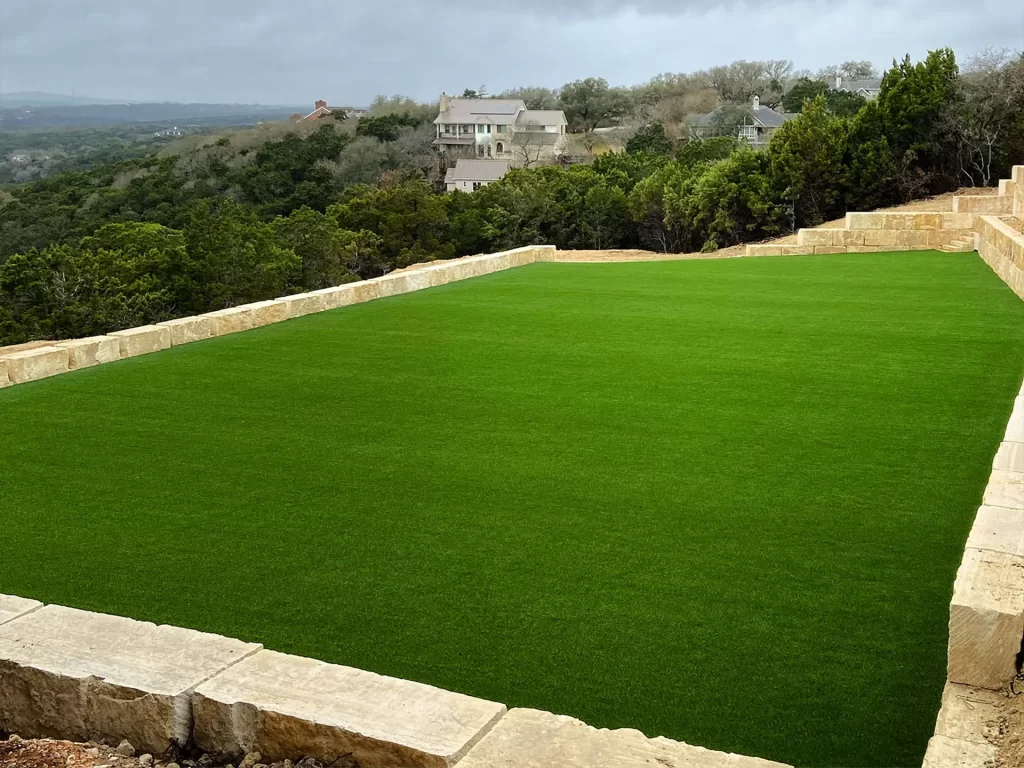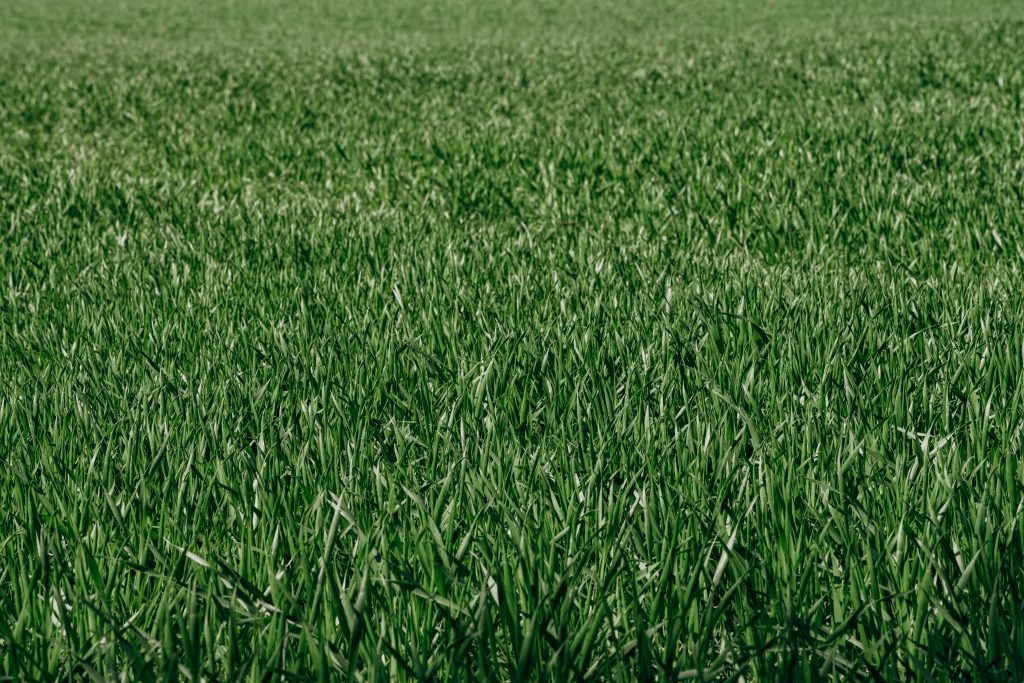When deciding on the best surface for your sports fields, backyards, or even a putting green, you might wonder whether to choose natural grass or artificial grass. At Magnolia Turf, we provide high-quality synthetic grass that meets a variety of needs.
To help you make the best decision, here are five pros and cons of artificial turf and natural grass.
Pros of Artificial Turf
1. Durability and Longevity
One of the biggest benefits of synthetic grass is its durability. Heavy use and bad weather can easily damage natural grass. However, artificial grass withstands intense activities and all types of weather.
Whether it’s a football game, a soccer match, or a putting green, synthetic grass stays in great condition year-round. It can last 10 to 15 years, reducing the need for frequent repairs and replacements.
2. Low Maintenance
Natural grass fields require a lot of upkeep, like mowing, watering, and fertilizing. Artificial grass reduces these maintenance needs. It doesn’t need watering, cutting, or chemical treatments, saving both time and money. This low-maintenance aspect makes synthetic grass a cost-effective choice for sports fields and backyards.
3. Consistent Playing Surface
Synthetic grass provides a smooth and even playing surface, which is important for performance and safety. Natural grass fields can become uneven and develop holes, increasing the risk of injuries. Artificial grass, however, stays level and uniform, creating a safer environment for athletes. This consistency helps players perform better because the surface won’t change suddenly.
4. Water Conservation
Saving water is important, especially in areas with droughts. Natural grass needs a lot of water to stay green and healthy. Synthetic grass doesn’t need watering, which helps conserve water and lowers water bills. This makes artificial grass an environmentally friendly option for sports fields and other areas.
5. All-Weather Usability
You can use artificial grass in any weather. Natural grass can become muddy and slippery in the rain or dry and hard in the sun, leading to canceled games. Synthetic grass drains quickly and stays stable, providing a playable surface in all weather conditions. This reliability means sports schedules can continue without interruption.

Cons of Artificial Turf
1. Initial Cost
Although installing artificial grass costs more at first, it saves a lot of money over time. The initial investment can be high, which might be a drawback for some. However, the long-term savings on water, fertilizers, pesticides, and maintenance equipment make it a cost-effective choice in the long run.
2. Heat Retention
Synthetic grass can get hotter than natural grass in direct sunlight. This heat retention can make the surface uncomfortable to play on during hot days. However, watering the turf or using shade structures can help mitigate this issue.
3. Synthetic Feel
While high-quality synthetic grass looks very realistic, it doesn’t have the same feel as natural grass. Some people prefer the natural texture of real grass underfoot. However, the benefits of durability, low maintenance, and all-weather usability often outweigh this drawback.
4. Installation Process
Installing artificial turf requires professional expertise to ensure it’s done correctly. The process involves preparing the ground, laying the turf, and securing it properly. While this ensures a long-lasting installation, it can be more complicated and time-consuming compared to planting natural grass.
5. Environmental Impact
While synthetic grass saves water and reduces the need for chemicals, it is made from plastic materials. This raises concerns about its environmental impact, especially at the end of its lifespan. However, many companies are now focusing on recycling options for old artificial turf to address this issue.
Pros of Natural Grass
1. Natural Feel and Look
Many people love the natural feel and look of real grass. It provides a softer surface for walking and playing, which some find more comfortable and aesthetically pleasing.
2. Cooler Surface
Grass stays cooler than synthetic turf in hot weather, making it more comfortable to play on during summer months. This is a significant advantage in areas with high temperatures.
3. Environmental Benefits
Grass helps absorb carbon dioxide and produces oxygen, contributing to a healthier environment. It also supports local ecosystems by providing habitat for various insects and wildlife.
Cons of Natural Grass
1. High Maintenance
Maintaining a natural grass field requires a lot of work. You need to mow, water, fertilize, and treat it for pests regularly. This can be time-consuming and costly.
2. Water Usage
Grass needs a lot of water to stay green and healthy, which can be a problem in drought-prone areas. High water usage also leads to higher water bills.
3. Durability Issues
Heavy use and bad weather can quickly damage natural grass, leading to bare patches and uneven surfaces. This requires frequent repairs and maintenance to keep it looking good.
4. Inconsistent Surface
Over time, natural grass fields can become uneven due to wear and tear. This can increase the risk of injuries and affect the quality of play.
5. Pesticides and Fertilizers
To keep grass healthy, you often need to use chemicals like pesticides and fertilizers. These can be harmful to the environment and costly over time.

Why Choose Magnolia Turf?
At Magnolia Turf, we provide top-quality artificial grass that meets the needs of sports fields. Here’s why you should choose us:
Quality Materials
We use only the best materials to make sure your artificial grass looks great and lasts for years. We design our products to handle heavy use and tough weather conditions.
Professional Installation
Our experienced team installs the artificial grass correctly and efficiently. We follow a detailed process to ensure your sports field is both functional and attractive.
Exceptional Customer Service
From the first consultation to post-installation support, we provide outstanding customer service. We work with you to understand your needs and make sure you are happy with your new sports field.
Conclusion
Choosing between artificial turf and natural grass depends on your needs and preferences. Artificial turf offers durability, low maintenance, and water conservation, while natural grass provides a cooler, natural feel. At Magnolia Turf, we offer high-quality artificial grass that improves the performance and look of sports facilities.
If you’re thinking about upgrading your sports field, contact Magnolia Turf today. We can help you get the perfect playing surface with our top-quality artificial grass.